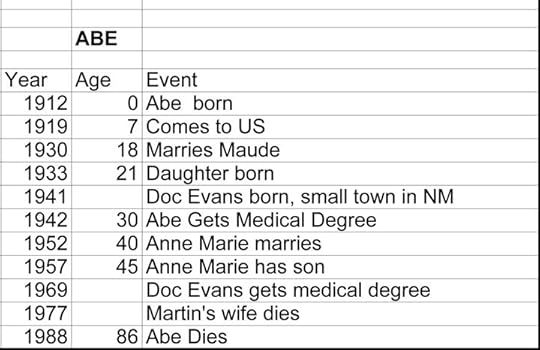Real Time in Fiction
 During my recaps of the Mystery Writers of America University sessions, one point that was made by several presenters was keeping track of what’s happened in “real time” during your story. Even if you’re not a plotter (raising hand), you do have to know what’s going on even if it’s not on the page.
During my recaps of the Mystery Writers of America University sessions, one point that was made by several presenters was keeping track of what’s happened in “real time” during your story. Even if you’re not a plotter (raising hand), you do have to know what’s going on even if it’s not on the page.
I’m not talking about back story here. I’m talking about the Big Picture. I ran into this yesterday when I reached the “tying thing up” phase in my current manuscript. Although I don’t plot most of the book, when it comes to the end, especially in a mystery, it’s important not to leave threads dangling.
This book covers multi-generations—not on the page, necessarily, but since the central crime in the book is a cold case, my cops are looking at things that happened decades ago, and the players aren’t necessarily still around. I have a core of potential suspects, and at some point, the cops have to discover the connections, both to each other and to the case.
I found that while I was writing, it was easy enough to toss names and some basic information out there, but once my cops started looking for these connections, I needed to backtrack—way back—and recreate the chronology.
In my romantic suspense books, I’m normally dealing with a very small cast–hero, heroine, and a few secondary characters. They also tend to be around the same age, usually in their mid-twenties to mid-thirties.
However, in this mystery, with its cold-case focus, I’m dealing with secondary characters who cover a much wider age range. It was easy enough when I was writing to say, “XX has a daughter and a grandson” but if said grandson was in his fifties, I had to figure out how old daughter and grandfather would have been.
I actually started a spreadsheet showing when each character in this group was born, created an abbreviated family tree, since I’m going back 3 generations. I did a lot of math, and a lot of number-juggling, to make sure I didn’t have characters giving birth at age 7, or joining the army when they were in their 40s, or living to be 107.
Although very little of these events are shown in the book, it’s important to make sure that you, as the author, knows what’s going on. So, although the book takes place in 2012, the cold case in this book happened in the mid 1970s, so I had to go back to 1912 and follow the lifeline of the character who ended up being the connecting element for the crime, even though he’s not even alive when the book starts.
 This is an abbreviated version–I added another column with more details about who was connected to whom, and how, but on the off chance some of you might read the book when it comes out, I didn’t want to include spoilers!
This is an abbreviated version–I added another column with more details about who was connected to whom, and how, but on the off chance some of you might read the book when it comes out, I didn’t want to include spoilers!
Would a reader stop and do the math? I don’t know. I don’t think I’d notice, but then, I’m the kind of reader who assumes the author made sure it was right. Which is why I feel compelled to make sure I get it right, too. (And if you see any math errors in my spreadsheet, feel free to let me know)
Special surprise field trip pictures tomorrow – I think you’ll enjoy them!




